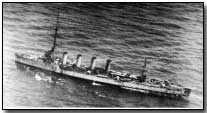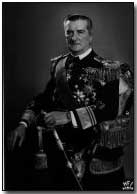Battles - The Battle of Otranto Straits, 1917
 Having mounted a series of ongoing assaults upon the Allied Otranto Barrage in the Mediterranean - usually whenever one of their
submarines was lost to an unknown cause - the Austro-Hungarian Navy
determined to launch a concerted attack on the night of 14/15 May 1917.
Having mounted a series of ongoing assaults upon the Allied Otranto Barrage in the Mediterranean - usually whenever one of their
submarines was lost to an unknown cause - the Austro-Hungarian Navy
determined to launch a concerted attack on the night of 14/15 May 1917.
The attack, planned by then-Captain Miklos Horthy de Nagybanya, was led by three light cruisers (Novaro, Helgoland and Saida, initially disguised as destroyers so as not to overly alarm the Allies) and two destroyers and was specifically directed against the ill-defended Allied anti-submarine trawlers which comprised the Barrage.
Having set sail from the port of Cattaro the Austro-Hungarian initiative began with an attack against an Italian munitions ship and its accompanying destroyer, sinking both.
The three cruisers proceeded to sail along the Otranto Barrage at 3.30am sinking fourteen Allied patrol craft in the space of two hours, having first given their hopelessly outgunned crews an opportunity to take to their escape crafts. In addition to the fourteen trawlers sunk many others were severely damaged.
Having wrought the desired level of damage the Austro-Hungarian force turned around and sailed back towards Cattaro. In the interim however a combined British, French and Italian flotilla had been despatched post-haste from Brindisi in an attempt to cut off the Austro-Hungarians. The Allied force included two British Town Cruisers, Dartmouth and Bristol, together with four Italian destroyers and Aquila, the flotilla leader.
 Having
eventually caught up with the Austro-Hungarians at 7.45am on 15 May the
resultant encounter, which on paper ought to have led to a clear-cut Allied
victory, saw the Austro-Hungarians escape in the face of poor Allied
tactics.
Having
eventually caught up with the Austro-Hungarians at 7.45am on 15 May the
resultant encounter, which on paper ought to have led to a clear-cut Allied
victory, saw the Austro-Hungarians escape in the face of poor Allied
tactics.
Aquila was disabled by Austro-Hungarian fire. During a high-speed chase two of the Allied destroyers suffered breakdowns and had to be left behind with escorts. Bristol meanwhile proved too slow for the chase with the consequence that only Dartmouth and two destroyers were left to pound the Austro-Hungarians from a distance, Novara being forced to a standstill.
However the Allied ships called off their pursuit once they detected the smoke of approaching Austro-Hungarian reinforcements at a distance. While returning Dartmouth was severely damaged via a German U-boat torpedo (U-25) and one of its accompanying destroyers was sunk by a mine.
As a consequence of the encounter the Italian naval Commander-in-Chief dismissed the Otranto Barrage as being essentially indefensible. The British disagreed but night-time patrols of the Barrage were nevertheless abandoned.
Success at the Otranto Straits brought Horthy much prestige; so much so that following the mutiny at Cattaro in March 1918, followed by the forced resignation of Admiral Njegovan, Horthy found himself promoted Rear Admiral and appointed Commander in Chief (Austria-Hungary's last) of the battlefleet over the heads of many more qualified officers.
Photographs courtesy of Photos of the Great War website
One in five of the Australians and New Zealanders who left their country to fight in the war never returned; 80,000 in total.
- Did you know?
